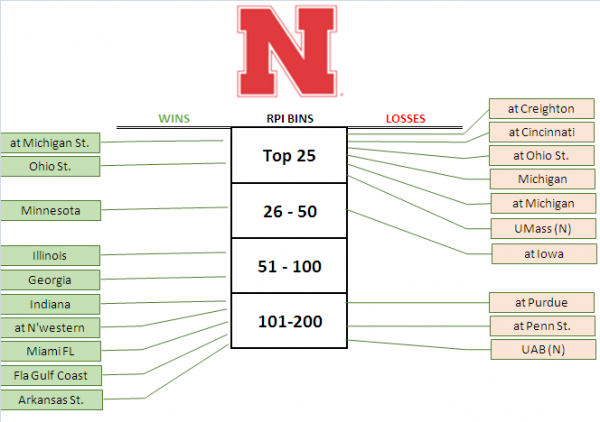Nebraska on the Bubble: Big Ten Schedule Both Helps and Hurts Huskers
Posted by Alex Moscoso (@AlexPMoscoso) on February 20th, 2014In Tuesday’s Morning Five, I stated matter-of-factly that it was unlikely Nebraska would make the NCAA Tournament. I based this off the fact that, despite their current three-game winning streak and impressive 6-6 record in the Big Ten, they already have 10 losses (including some bad ones) and six more games to go in one of the toughest leagues in America. But after reading CBSSports’ Gary Parrish article that further examined the Cornhuskers’ record, I think I may have been too quick to dismiss their hopes. The crux of Parrish’s article is that, despite the Cornhuskers’ high number of losses, Nebraska has as many quality wins as most bubble teams, and a majority of their losses are against elite competition. He points out that Tim Miles’ team has as many top-50 RPI wins (three) as some other surefire NCAA Tournament teams: Ohio State, Virginia, Louisville, Memphis, and Connecticut. In this post, I will illustrate Nebraska’s resume, analyze Parrish’s findings, and identify what may be the main point of contention working against the Cornhuskers on Selection Sunday.
The infographic below illustrates the makeup of Nebraska’s resume against teams grouped by RPI bins. Teams with an “(N)” next to their name represent a game played on a neutral court. Not shown are Nebraska’s four wins against teams with an RPI of #200 or more.
From the illustration above, we see that Nebraska’s conference affiliation has been both advantageous and hurtful this season. Because the Cornhuskers are part of the Big Ten, they’ve had multiple chances to face elite competition. By the same token, Miles’ team has been able to upset a number of top-50 teams, but they’ve also stacked up a heavy number of losses against very good teams (the Huskers carry a 3-7 record against top-50 competition). By way of a comparison, all but one of the teams mentioned in Parrish’s article that also has three top-50 wins have four or less losses against the same group — Memphis has six losses against the top-50 but no losses outside that group.
Looking ahead at Nebraska’s remaining schedule, the Cornhuskers have one more game against a Top 25 team (Wisconsin), while the rest of their games include one top-50 squad (at Illinois) and four sub-50 teams (Penn State, Purdue, Northwestern, at Indiana). Assuming they don’t beat the Badgers, the Cornhuskers are likely to finish with a top-50 record of 3-8 (0.272) and fewer than 20 total regular season wins. Parrish is correct that Nebraska has a strong case for the bubble due to some big wins and the relatively easy schedule it has going forward. But even if they finish strongly, how will its lopsided record compare with other bubble teams like SMU, Georgetown and Gonzaga? (That trio, by the way, sports records of 3-3, 3-5, and 1-2, respectively, against the top-50.)
Those teams play a smaller sample size of games against elite teams, which is an underlying factor in each of their records. And the selection committee is supposed to take relative strength of schedules into account, which certainly works in favor of the Cornhuskers with the 22nd most difficult schedule in college basketball to date. Will all of that be enough to overcome a probable 3-8 record against the top-50, in addition to those three other bad losses? I won’t make assumptions, but this surely could be the main point of discussion when the selection committee decides if Nebraska receives a bid to the NCAA Tournament for the first time in almost two decades.













































